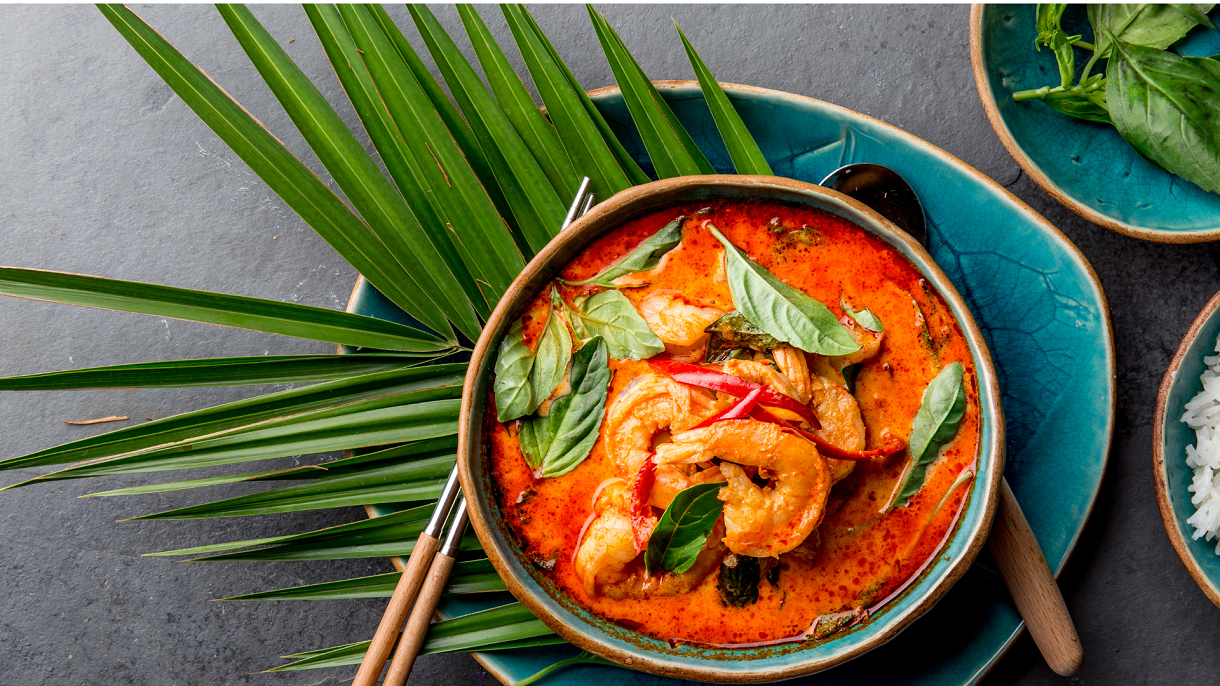Introduction
In Thailand’s rich culinary tapestry, few dishes boast the boldness and complexity of Curry Prawn Soup. This fusion creation combines the aromatic spices of Thai curry with the comforting warmth of traditional soup, resulting in a harmonious blend of flavors that tantalize the taste buds. Join us as we delve into the origins, ingredients, preparation, and cultural significance of Thailand’s beloved Curry Prawn Soup.
Origins and Fusion
Curry Prawn Soup, born from the bustling streets of Bangkok, represents Thailand’s culinary ingenuity and its openness to fusion cuisine. While curry has roots in South Asia and soup in various cultures, Thai chefs have skillfully melded these diverse culinary traditions to create a dish that reflects the country’s vibrant food culture.
Ingredients: A Symphony of Spice
At the heart of Curry Prawn Soup lies its rich, aromatic broth infused with the complex flavors of Thai curry. Fragrant spices such as lemongrass, galangal, and kaffir lime leaves blend with creamy coconut milk and fiery Thai chilies, creating a broth that’s simultaneously spicy, creamy, and deeply flavorful.
Fresh prawns, tender and succulent, take center stage in this dish, adding a delicate sweetness that complements the boldness of the curry-infused broth. Tender rice noodles, immersed in the rich curry broth, provide a satisfying base for the explosion of flavors.
Preparation: A Culinary Symphony
Crafting the perfect bowl of Curry Prawn Soup requires patience, skill, and a keen understanding of flavor profiles. The process begins with sautéing the aromatic curry paste to release its essential oils and intensify its flavors.
Fresh prawns are then added to the pot, infusing the broth with their natural sweetness and depth. Meanwhile, rice noodles are cooked until tender yet slightly chewy, ready to soak up the rich, flavorful broth.
Once all components are prepared, the dish is assembled with care, ensuring that each element contributes to the overall harmony of flavors. Garnished with fresh herbs like cilantro, Thai basil, and spring onions, Curry Prawn Soup is a feast for both the eyes and the palate.
Cultural Significance: A Culinary Fusion
Curry Prawn Soup holds a special place in Thai culinary culture, symbolizing the country’s diverse culinary heritage and its embrace of fusion cuisine. Whether enjoyed as a quick street-side snack or as part of a lavish feast, Curry Prawn Soup embodies the spirit of Thai hospitality and culinary creativity.
In addition to its culinary significance, Curry Prawn Soup reflects Thailand’s cultural diversity, celebrating the country’s rich tapestry of culinary traditions and influences. It serves as a bridge between East and West, bringing together the bold flavors of Thai curry with the comforting warmth of traditional soup.
Conclusion
Curry Prawn Soup is a culinary masterpiece that showcases the bold flavors and creative spirit of Thailand. With its rich, aromatic broth, succulent prawns, and tender rice noodles, Curry Prawn Soup offers a tantalizing journey for the taste buds, inviting diners to explore the vibrant flavors of Thai cuisine.
So, the next time you’re craving a taste of Thailand, why not indulge in a steaming bowl of Curry Prawn Soup? It’s a culinary experience that’s sure to transport you to the bustling streets of Bangkok, where bold flavors and aromatic spices await at every corner.
Questions And Answer’s:
- Question: What is the significance of the red curry paste in Thai cuisine? Answer: Red curry paste is a fundamental ingredient in Thai cuisine, known for its vibrant color and robust flavor profile. It typically contains ingredients such as dried red chilies, lemongrass, garlic, shallots, galangal, and shrimp paste. The paste is used to add depth and spiciness to various Thai dishes, including curries, soups, and stir-fries.
- Question: How does the geography of Thailand influence its culinary traditions? Answer: Thailand’s geography, characterized by fertile plains, tropical forests, and a lengthy coastline, greatly influences its culinary traditions. The abundance of fresh produce, herbs, spices, and seafood has led to a diverse and flavorful cuisine. Different regions of Thailand have distinct culinary styles, with northern cuisine featuring hearty dishes like khao soi, while southern cuisine highlights seafood curries and spicy salads.
- Question: Can you explain the significance of the traditional Thai dessert, mango sticky rice? Answer: Mango sticky rice, known as “khao niew mamuang” in Thai, is a beloved dessert that holds cultural significance in Thailand. It consists of ripe mangoes served with sweet sticky rice, drizzled with coconut milk and sprinkled with toasted sesame seeds. This dessert is often enjoyed during the summer months when mangoes are in season and is considered a symbol of prosperity and abundance.
- Question: What role do fresh herbs play in Thai cooking, and why are they essential? Answer: Fresh herbs are a cornerstone of Thai cooking, adding brightness, aroma, and complexity to dishes. Herbs like Thai basil, cilantro, and lemongrass are commonly used to enhance flavors and balance spice levels. These herbs not only contribute to the distinctive taste of Thai cuisine but also offer health benefits, including antioxidant properties and digestion aid.
- Question: How does Thai cuisine incorporate the concept of balance, and why is it important? Answer: Thai cuisine emphasizes the balance of flavors, including sweet, sour, salty, bitter, and spicy. This balance is achieved by carefully combining contrasting ingredients and seasonings in each dish. For example, a spicy curry might be balanced with the sweetness of coconut milk and the acidity of lime juice. This harmony of flavors creates a well-rounded and satisfying culinary experience, making Thai cuisine both delicious and memorable.

